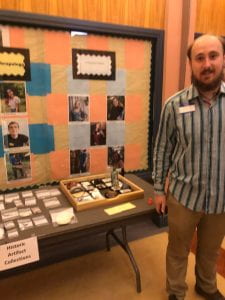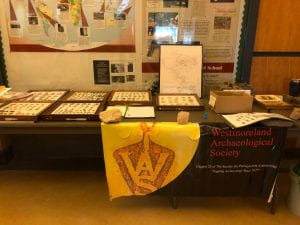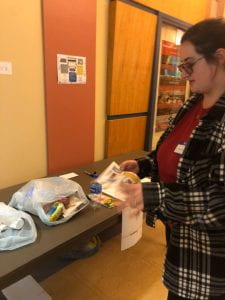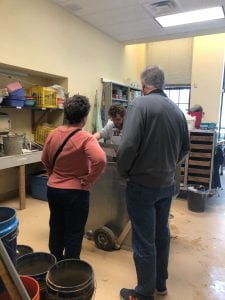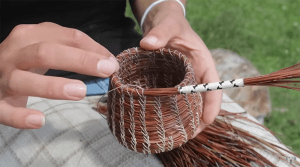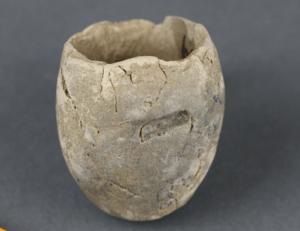Homecoming was this past Saturday, and it was packed with fun events and activities, celebrations, a parade, a football game, and the crowning of the Crimson Homecoming Court. In America, the idea of selecting a Homecoming court and having a King and Queen arose in the 1930s. Originally, Kings and Queens were chosen based on the float the came in on during the Homecoming parade. The crowning of royalty is something other parts of the world are exposed to as well. With the recent passing of Queen Elizabeth II, sometime in 2023 King Charles III will be crowned during a coronation ceremony. In August of this year Misuzulu Zulu was crowned as the new Zulu king in South Africa, wearing a headdress of traditional leopard skin and black feathers.

Princess Blanche’s crown, ca.1399
Although receiving a cheap, bedazzled crown after being voted as the most popular by classmates does not really compare to the coronation of British or Africa royalty, the ceremonies do have something in common; something worn on the head as a symbol of royalty, leadership, and power. Typically called a crown or headdress, these physical symbols are usually made out of rare or symbolic materials, and they legitimize who is in charge and who has the authority to sometimes do whatever they want.
The oldest known crown belonging to the British royal family is the Princess Blanche’s crown, that dates to around 1399; it is set with pearls, diamonds, sapphires, rubies, and emeralds. Although the origins of the royal crowns we recognize today reach back to the emperors of the Roman Empire, crowns, headdresses, and other forms of adornment that showcase the leader of the group have been used by other civilizations across the world in many different periods of time.
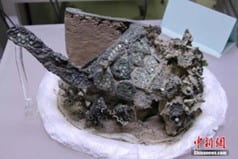
Empress Xiao’s crown before it was cleaned, CNS/Tian Jin
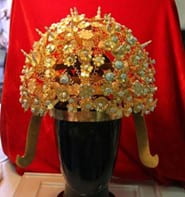
Empress Xiao’s crown after it was cleaned, CNS/Tian Jin
In 2012, archaeologists in China uncovered a 6th century crown that originally belonged to Empress Xiao from the Sui dynasty (AD 581-618). It is the oldest imperial crown ever discovered in China, found in a tomb in Yangzhou, in the modern-day Jiangsu Province. The crown had been resting in a rotten wooden box and was restored at the Cultural Relic Protection Institute in Shaanxi Province. It was decorated with pearls, cotton, silk, fragile copper wires, and thirteen flower decorations, each composed of gilded bronze wires with delicate representations of stalks, stamens, and petals.
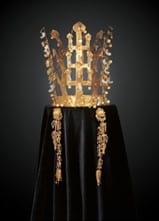
Silla Gold Crown, National Museum of Korea
In Korea, five gold crowns excavated from five royal tombs, helped the ancient capital of Guemseong, modern day Gyeongju, justify the meaning of its name, ‘city of gold.’ The five crowns are from the Silla Kingdom that extended their rule from southeast Korea during the Three Kingdoms period (57 BC-AD 668) all the way to the Unified Silla Kingdom period (AD 668-935). The crowns belonged to Silla kings and queens who were buried in large, stone-lined tombs within earth mounds, when they passed. The crowns were preserved and survived because of the clay placed between the layers of stone, the lack of horizontal entrances to the tombs, and the fact that the tombs were never looted. The first of the National Treasures of Korea were found in 1921 in a tomb known as the Gold Crown tomb that dated to the second half of the 5th century. The other four tombs with their crowns were found nearby and are called the Great Tomb at Hwangnam, Cheonmachong (the ‘Heavenly Horse Tomb’), the Gold Bell Tomb, and the Auspicious Phoenix Tomb. The Silla crowns are made up of three parts, an openwork tall conical cap, a piece resembling a wing or butterfly which fits into the cap, and a diadem; chains with pendants also hang from the sides of the crowns. In addition to the embellished, sheet-cut gold pieces that form the crowns, they are adorned with jade pendants.

Baekje Gold Crown Ornaments
Researchers note similarities to gold crowns from the Black Sea area, Bactria, Japan, and China. Baekje and Goguryeo, the other two kingdoms from the Three Kingdoms period besides Silla, also had crowns. Recognized Goguryeo crowns were made of guilt-bronze, but Baekje has famous crown ornaments, in addition to crowns, known as Geumjegwansik attributed to their kingdom, that were excavated from a tomb in Gongju, South Korea in 1971. The two gold diadems are shaped like flames with flower and vine-like patterns and were worn by the king of Baekje. They were found in the tomb of King Muryeon who was in power from AD 501-523.
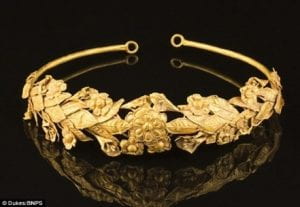
Gold Greek wreath
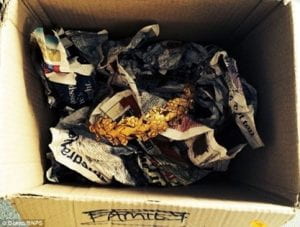
Box the crown was found in
In 2016 a man found a 2,300-year-old Greek myrtle wreath dating to around 300 BC underneath his bed. The crown, valued at over 100,000 English pounds, was in a cardboard box in Somerset, England. Usually worn for religious ceremonies or given as prizes at athletic and artistic contests, the crown from Ancient Greece is pure gold, handmade, and weighs about 100 grams.

Assyrian crown
Tombs dating to around 750-700 BC were found by Iraqi archaeologists in 1990. One contained a gold crown with trellis vines, lapis-lazuli grapes, four-winged robed figures, and rows of pomegranates and rosettes. The crown was from the ancient Assyrian empire of Mesopotamia and the tombs were found under the floors of rooms in Ashurnasirpal II’s (883-859 BC) harem.

Late Indus Valley civilization copper crown remnants, A.K. Pandey/Archaeological Survey of India
Archaeologists uncovered a 4,000-year-old copper crown in modern day India in 2015 that belonged to the late Indus Valley civilization. It is one of two crowns from an Indus Valley site ever recovered, was found resting on a skull, and is decorated with a carnelian and a fiance stone. Along with the skeleton and crown, pottery and animal bones were also found nearby. Researchers suggest that this person could have been someone important, like a local leader of some kind, based on the crown. However, the crude, simple, local decorations on the pottery, suggest that this person might have not been all that powerful, that they were more likely to have been someone who was rich or had good taste, rather than a political figure.

6,000-year-old Dead Sea Cave crown
One crown that has claimed to be the oldest in the world is a 6,000-year-old crown found in 1961 in a Dead Sea Cave. The cave was in the Galilean highlands of the Judean Desert of Israel and recovered by archaeologists Pessah Bar-Adon. The crown dates to the Copper Age between 4000-3500 BC, more specifically the Chalcolithic period (4500-3600 BC), and was amongst 400 other artifacts in the cave, a finding that has become known as the Nahal Mishmar Hoard. The thick copper ring with vultures and doors jutting from the top was one of five crowns from the hoard. The objects are thought to have been placed in the cave for safe keeping, and from the Chalcolithic Temple of Ein Gedi, which is around 12 kilometers away. Some question if the “world’s oldest crown” was even used as a crown at all; perhaps it was a stand for an urn, or something else, but the seven-inch tall with about equal diameter band of blackened copper, is eye-catching, with its rim of pointed figures, hilt-shaped cross, long-necked birds, and gates or grilles with horns.
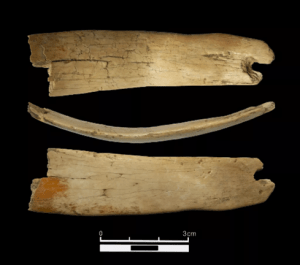
The largest fragment of the ivory tiara found in the Denisova Cave, depicted from three separate angles, Institute of Archeology and Ethnography
The claim to the “world’s oldest crown” is challenged by what some believe is a 35,000-50,000-year-old crown or headband made of woolly mammoth tusk ivory and broken into three pieces. Rediscovered by archaeologists in a Denisova Cave in the Altai mountains of Siberia, the head piece was worn by a man, but it is up for speculation if it was used to designate royalty or leadership, a mark of a family or tribe, or if it was just used to hold his hair back. Diadems such as these are rare, and there would have been several steps taken to create this item. The tusks would have to have been separated from the animal, cut into pieces, soaked in water to be shaped, then physically shaped, scraped, cut, grinded, drilled, and finally polished. This crown was too long to be a bracelet, had microscopic wear that showed it had contact with organic material like skin, was bent to fit to an adult male’s temple, and the longest piece had half a hole on one side drilled into it that was most likely used with cords or straps to affix to the head; all reasons that contributed to the belief that these pieces of ivory potentially had a crown-like function.

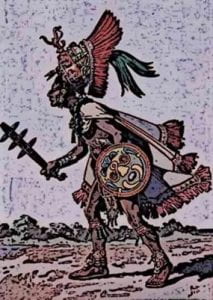 Crowns and other head-adorning symbols of leadership are prevalent in many other societies and civilizations; some have survived, while others are recognized through art, written records, oral histories, carvings, and sculptures. Native Americans in Pre-Columbian times wore headdresses, headbands, and war bonnets, in various styles and sizes depending on the tribe and location in the country. They could be made from the hairs of animals such as porcupines, moose, and deer’s tails, from feathers, buffalo fur and horns, and otter fur and tails, in addition to beads, quillwork, and decorative patterns. Ancient Maya headdresses were worn by the elite, with the King’s being the largest, the larger the headdress the more important the person. Wood, cloth, jade, shells, and colorful feathers were used to carefully craft these headdresses that were made to look like animals that were important to the culture, such as the jaguar, snake, or falcon. The quetzal bird was coveted by the Mayan culture and its feathers were used solely for royalty.
Crowns and other head-adorning symbols of leadership are prevalent in many other societies and civilizations; some have survived, while others are recognized through art, written records, oral histories, carvings, and sculptures. Native Americans in Pre-Columbian times wore headdresses, headbands, and war bonnets, in various styles and sizes depending on the tribe and location in the country. They could be made from the hairs of animals such as porcupines, moose, and deer’s tails, from feathers, buffalo fur and horns, and otter fur and tails, in addition to beads, quillwork, and decorative patterns. Ancient Maya headdresses were worn by the elite, with the King’s being the largest, the larger the headdress the more important the person. Wood, cloth, jade, shells, and colorful feathers were used to carefully craft these headdresses that were made to look like animals that were important to the culture, such as the jaguar, snake, or falcon. The quetzal bird was coveted by the Mayan culture and its feathers were used solely for royalty.
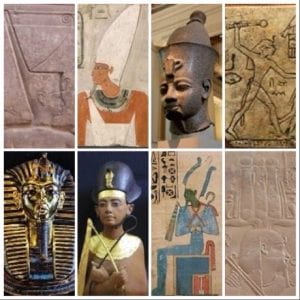 Ancient Egyptian pharaohs also had recognizable crowns and headdresses, each with a certain meaning indicated by their shape. The Deshret or Red Crown, established the king as the ruler of Lower Egypt. No physical examples of this crown survive today. Hedjet, the White Crown, establishes the king’s rule over southern Egypt; it too has no surviving example. The Pschent, the Double Crown, also known as Sekhemti or the “Two Powerful Ones”, symbolizes the king’s rule over both Upper and Lower Egypt. This crown is the merging of the Red and White Crowns, a move done under King Narmer during the Pharaonic period (3000 BC-332 BC). Nemes, was a striped head cloth that is easily recognized as being worn by King Tutankhamun on his coffin. The earliest depiction of this headdress was found on an ivory label of King Den from the 1st dynasty. It was typically worn to cover a crown and the backside of the head. The Khepresh, or Blue Crown, made from stained leather, became popular by the 18th dynasty, but is known as a war crown, as it was depicted often as being worn by Ramesses II in the Battle of Kadesh. The Atef Crown was the crown of the first mythical king Osiris but was worn by other deities. Its earliest depiction is of being worn by the Pharaoh Sahure in the 5th dynasty of the Old Kingdom. The Hemhem or Triple Atef became popular during the reign of Akhenaten (1353-1336 or 1351-1334 BC) and the Ptolemaic period or dynasty (323/305-30 BC). It was a variation of the Atef Crown, was also called the “Roaring One”, and was worn by Heka, the god of magic.
Ancient Egyptian pharaohs also had recognizable crowns and headdresses, each with a certain meaning indicated by their shape. The Deshret or Red Crown, established the king as the ruler of Lower Egypt. No physical examples of this crown survive today. Hedjet, the White Crown, establishes the king’s rule over southern Egypt; it too has no surviving example. The Pschent, the Double Crown, also known as Sekhemti or the “Two Powerful Ones”, symbolizes the king’s rule over both Upper and Lower Egypt. This crown is the merging of the Red and White Crowns, a move done under King Narmer during the Pharaonic period (3000 BC-332 BC). Nemes, was a striped head cloth that is easily recognized as being worn by King Tutankhamun on his coffin. The earliest depiction of this headdress was found on an ivory label of King Den from the 1st dynasty. It was typically worn to cover a crown and the backside of the head. The Khepresh, or Blue Crown, made from stained leather, became popular by the 18th dynasty, but is known as a war crown, as it was depicted often as being worn by Ramesses II in the Battle of Kadesh. The Atef Crown was the crown of the first mythical king Osiris but was worn by other deities. Its earliest depiction is of being worn by the Pharaoh Sahure in the 5th dynasty of the Old Kingdom. The Hemhem or Triple Atef became popular during the reign of Akhenaten (1353-1336 or 1351-1334 BC) and the Ptolemaic period or dynasty (323/305-30 BC). It was a variation of the Atef Crown, was also called the “Roaring One”, and was worn by Heka, the god of magic.
The craftsmanship that has gone into making crowns of all shapes, sizes, and materials throughout the centuries is astounding. But archaeologists have to be careful when determining what should be labeled as a crown, or whether the artifact they are studying just resembles the familiar shape. From fakes to mistakes, like when researchers initially concluded that a 6th century bucket fitting was a crown, archaeologists and scholars need to be vigilant when examining and labeling artifacts.
Crowns will always fascinate people because of what they stand for; power, authority, and even popularity. They are still used by royal families, in Halloween costumes, and to adorn the heads of Homecoming Queens and Kings today. As you celebrate occasions such as Homecoming, take some time to recognize that so many of the mundane parts of customs we celebrate today, are reflections of objects used in ancient traditions for many, many years.
Follow IUP Anthropology on Facebook, Twitter, and Instagram
Further Reading and Sources:
https://visual.ly/community/Infographics/history/history-homecoming
https://www.dw.com/en/south-africa-thousands-witness-crowning-of-new-zulu-king/a-62877697
https://www.grunge.com/865856/this-is-the-oldest-known-british-royal-family-crown/
https://www.ancient-origins.net/news-history-archaeology/6th-century-crown-chinese-empress-revealed-first-time-its-full-glory-006631
https://www.worldhistory.org/article/957/the-gold-crowns-of-silla/
https://www.worldhistory.org/image/5961/baekje-gold-crown-ornaments/
https://www.primidi.com/crown_of_baekje/national_treasure_of_korea_no154
https://www.dailymail.co.uk/news/article-3610916/Incredibly-rare-2-300-year-old-Ancient-Greek-gold-crown-worth-100-000-kept-decades-tatty-box-old-newspapers-bed-owner-no-idea-was.html
https://www.bbc.co.uk/history/ancient/cultures/mesopotamia_gallery_08.shtml
https://www.ancient-origins.net/news-history-archaeology/4000-year-old-copper-crown-found-india-002558
https://www.thehistoryblog.com/archives/34290
https://www.ancient-origins.net/news-history-archaeology/6000-year-old-crown-found-dead-sea-cave-revealed-001436
https://www.newyorker.com/culture/culture-desk/the-worlds-oldest-crown
https://www.livescience.com/64297-ancient-woolly-mammoth-tiara-denisova-cave.html
https://theamericanhistory.org/important-facts-native-american-headdresses.html#:~:text=The%20roach%20headdresses%2C%20also%20known%20as%20porcupine%20roaches%2C,headdresses%20were%20often%20worn%20by%20dancers%20and%20warriors.
https://mayansandtikal.com/mayan-clothing/mayan-headdresses-clothes/
https://ancientegyptonline.co.uk/crowns/
https://www.ancient-origins.net/ancient-places-africa-news-general-opinion/crowns-pharaohs-00579
https://quickjewelryrepairs.com/articles/what-is-the-history-of-the-royal-crowns/#:~:text=The%20oldest%20crown%20in%20the%20world%20was%20discovered,of%20this%20culture%20is%20their%20mastery%20of%20coppersmithing.
https://www.dw.com/en/a-crown-or-a-bucket-when-archaeologists-make-mistakes/a-46807172

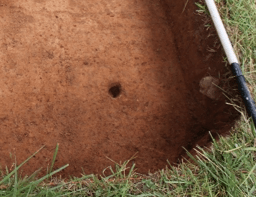



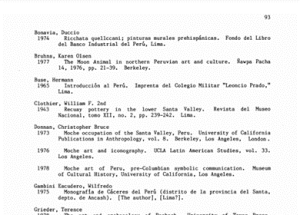
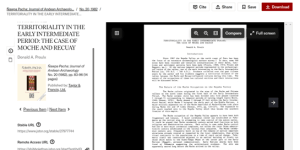


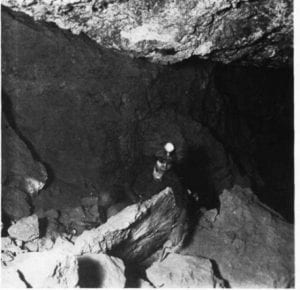


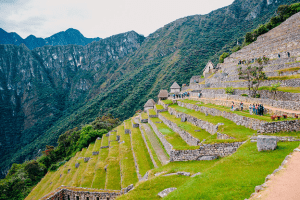
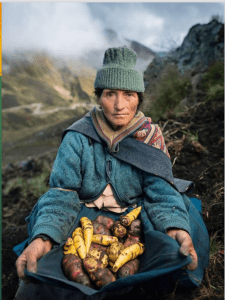
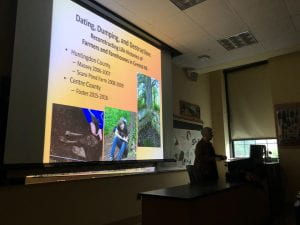 On November 2nd, Dr. Claire Milner, Emeritus Curator and Director of Exhibits at Penn State’s Matson Museum of Anthropology, joined us for her presentation, “Dating, Dumping, and Destruction: Reconstructing Life Histories of Farmers and Farmhouses in Central Pennsylvania.” She described three Penn State archaeological field schools she ran as project director at farmsteads in Central Pennsylvania. Two sites were excavated in Huntingdon County, the Massey site from 2006-2007 and the Scare Pond Farm from 2008-2009. She led excavations at the Foster site in Centre County from 2015-2016, as well.
On November 2nd, Dr. Claire Milner, Emeritus Curator and Director of Exhibits at Penn State’s Matson Museum of Anthropology, joined us for her presentation, “Dating, Dumping, and Destruction: Reconstructing Life Histories of Farmers and Farmhouses in Central Pennsylvania.” She described three Penn State archaeological field schools she ran as project director at farmsteads in Central Pennsylvania. Two sites were excavated in Huntingdon County, the Massey site from 2006-2007 and the Scare Pond Farm from 2008-2009. She led excavations at the Foster site in Centre County from 2015-2016, as well.



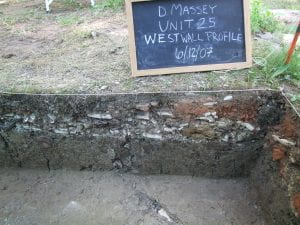
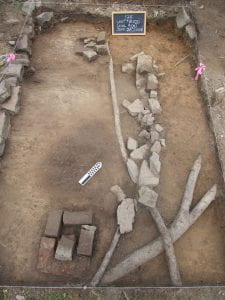


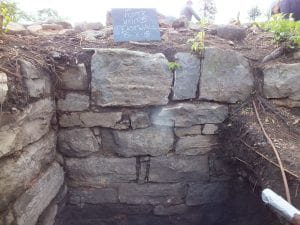
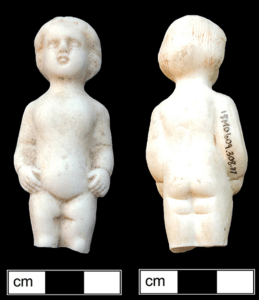
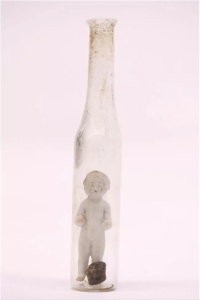



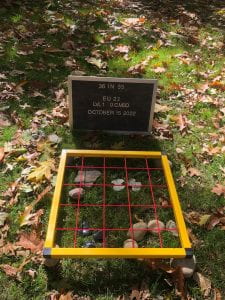
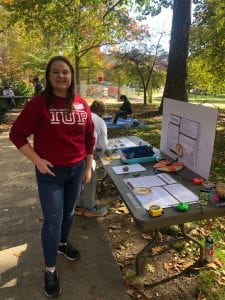
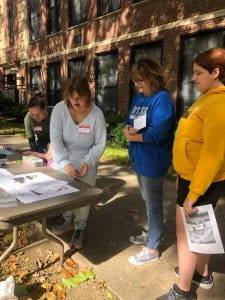






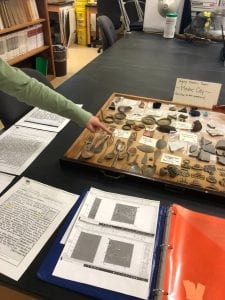
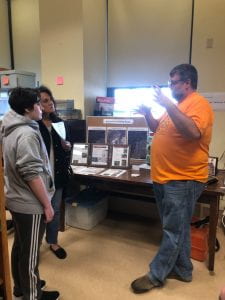

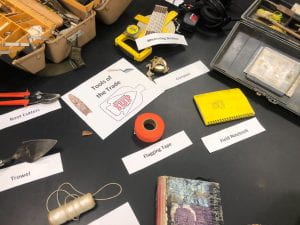 Dr. Chadwick, a professor here at IUP, were also in this room, discussing the PHAST (PennDOT Highway Archaeological Survey Team) program, what goes inside a dig kit, and what some of the geophysical tools used in archaeology are and how they operation. These such geophysical instruments included metal detectors and ground-penetrating radar.
Dr. Chadwick, a professor here at IUP, were also in this room, discussing the PHAST (PennDOT Highway Archaeological Survey Team) program, what goes inside a dig kit, and what some of the geophysical tools used in archaeology are and how they operation. These such geophysical instruments included metal detectors and ground-penetrating radar.